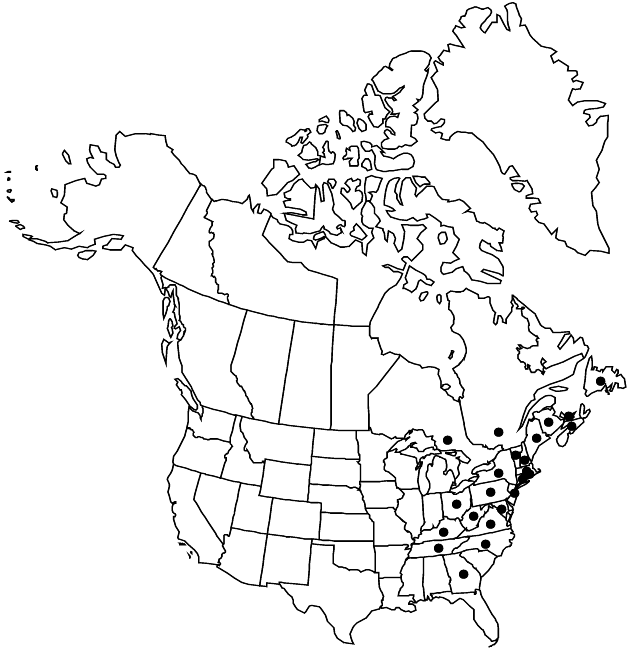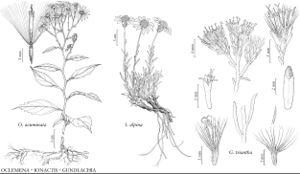Oclemena acuminata
Leafl. Bot. Observ. Crit. 1: 4. 1903.
Plants (2–) 10–80 (–100) cm (in extensive, lax clones; rhizomes superficial, elongate, herbaceous or woody, simple). Stems 1, erect, stout (2–4 mm diam.), flexuous, simple, ± densely villosulous, eglandular. Leaves 11–18, sometimes ± crowded distally (often seemingly whorled), proximal often withering by flowering; sessile or winged-subpetiolate; blades obovate to oblanceolate, (20–) 60–150 (–170) × (2–) 10–45 (–50) mm, bases cuneate to attenuate, margins flat, serrate distally, teeth sharp, acuminate, ciliate, apices acuminate, faces sparsely villosulous (abaxial mostly along veins and very sparsely stipitate-glandular; array leaves reduced distally). Heads (1–) 5–46 (–61+) in open corymbiform arrays, branches arching-ascending, at nearly right to ± acute angles with stems. Peduncles thin, 0.9–4.5 cm, densely villosulous, eglandular; bracts 1–2, linear, sparsely villosulous. Involucres 5–10 mm. Phyllaries linear-lanceolate to linear, sparsely villosulous or glabrous, sparsely gland-dotted. Ray-florets (9–) 15 (–18); corollas white, seldom pinkish, 15–20 × 1.4–2 mm. Disc-florets 14–30; corollas ampliate, 5.5–7.5 mm, sparsely glandular; tubes shorter than narrowly campanulate, sparsely strigillose throats, lobes reflexed, 0.5–1 mm. Cypselae tan, fusiform-obconic, ± compressed, 2.8–3.6 mm, ribs 3–5 (concolorous with bodies), faces glabrous, gland-dotted; pappi of whitish bristles in 3 series, outer shorter than disc corollas (innermost attenuate). 2n = 18.
Phenology: Flowering late summer–early fall.
Habitat: Cool, mesic to humid forests with usually well-drained, often acidic soils, from red spruce-Fraser fir Appalachian forests (south) to hemlock-white pine-northern hardwoods or Acadian forests, aspen-white birch groves or southern-exposed, open fir forests (north), sometimes clearings and forest edges, ridges
Elevation: 0–2000 m
Distribution

N.B., Nfld. and Labr. (Nfld.), N.S., Ont., P.E.I., Que., Conn., Ga., Ky., Maine, Md., Mass., N.H., N.J., N.Y., N.C., Ohio, Pa., R.I., Tenn., Vt., Va., W.Va.
Discussion
Oclemena acuminata is an Appalachian element. It may be extirpated from Ohio. L. Brouillet and J.-P. Simon (1981) discussed its distribution and ecology. It is adapted to mesic forest environments with relatively low light levels, with mid leaves larger or leaves pseudoverticillate to maximize light capture while minimizing self-shading. Such pseudoverticillate phenotypes have been called A. acuminatus forma subverticillatus Fernald; they are not recognized here (forma acuminatus has regularly dispersed leaves). When growing in exposed habitats, at forest edges, in clearings, or on ridges, O. acuminata is often chlorotic and reduced in size. Hypothesized introgression from O. nemoralis in the southern Appalachians (L. M. Hill 1976), far to the south of the latter’s range, based on morphologic and chemical data, appears unlikely and may represent misinterpretation of such chlorotic individuals. The species has been the object of autecologic studies (Brouillet and Simon 1979, 1980; L. F. Pitelka et al. 1980, 1983, 1985; A. A. Winn and Pitelka 1981; J. W. Ashmun et al. 1985; Pitelka and W. F. Curtis 1986). Aster acuminatus forma discoideus Kuntze, forma subdiscoideus Kuntze, and forma virescens Victorin & J. Rousseau apply to sterile phenotypes in which florets are replaced by bracts; forms are not recognized here.
Selected References
None.
Lower Taxa
"[" is not declared as a valid unit of measurement for this property."]" is not declared as a valid unit of measurement for this property."thin" is not a number.
